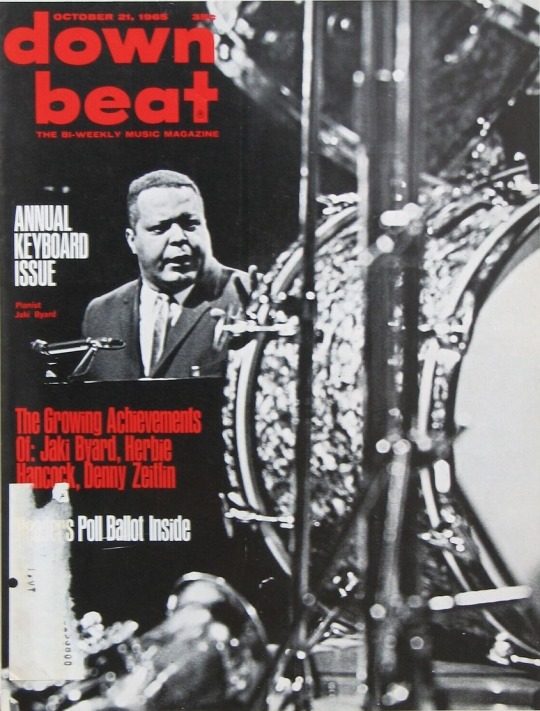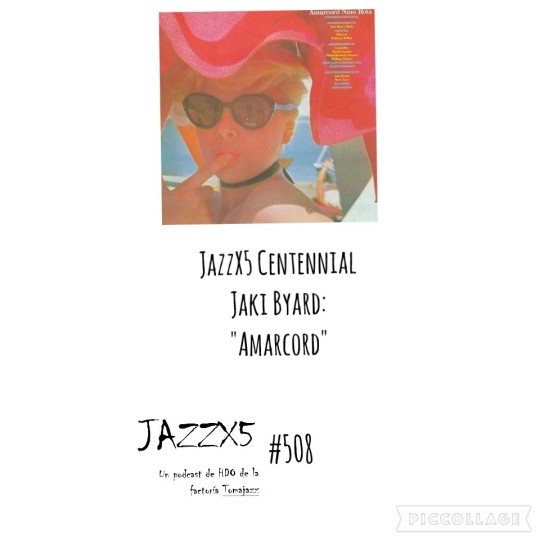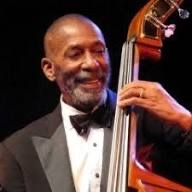#Jaki Byard
Text

#eric dolphy#sam shepard#charles mingus#jaki byard#dannie richmond#1963#1964#jazz#bass clarinet#bass clarinet ftw#quotes
68 notes
·
View notes
Text
Exploring the Genius of Charles Mingus: A Deep Dive into "The Great Concert of Charles Mingus"
Introduction:
Charles Mingus’ live album, “The Great Concert of Charles Mingus,” recorded on April 19, 1964, at the Théâtre des Champs-Élysées in Paris, stands as a monumental achievement in jazz history. Released in 1971, this triple album captures Mingus’ innovative spirit and showcases his exceptional band featuring Eric Dolphy, Clifford Jordan, Jaki Byard, Dannie Richmond, and on some…

View On WordPress
#Charles Mingus#Classic Albums#Clifford Jordan#Dannie Richmond#Eric Dolphy#Jaki Byard#Jazz History#Johnny Coles#The Great Concert of Charles Mingus
4 notes
·
View notes
Text

Downbeat - October 21, 1965 - Jaki Byard
11 notes
·
View notes
Video
youtube
Dolphy (Live - #) - Jaki Byard Quartet with Joe Farrell
1 note
·
View note
Text
Jaki Byard. JazzX5 Centennial #508 Por Pachi Tapiz [Minipodcast de jazz]
Jaki Byard. JazzX5 Centennial #508 Por Pachi Tapiz [Minipodcast de jazz]
“Amarcord”
Jaki Byard (y otros) Amarcord Nino Rota (Hannibal Records, 1982)
Jaki Byard. El tema es una composición de Nino Rota.
¿Sabías que?
Jaki Byard nació el 15 de junio de 1922.
Aunque se le conoció como Jaki Byard su verdadero nombre fue John Arthur Jr. Byard.
Aunque se le conoce especialmente como pianista, fue también saxofonista, trompetista, contrabajista, chelista, trombonista,…

View On WordPress
0 notes
Text

Jaki Byard – There’ll Be Some Changes Made
There’ll Be Some Changes Made (also released as Empirical) is an album by pianist Jaki Byard recorded in 1972 and released on the Muse label.
“Jaki Byard’s solo piano set for Muse ranges in styles from ragtime and stride to bop and the avant-garde. In addition to some off-the-wall choices (including “There’ll Be Some Changes Made,” “Besame Mucho” and Leonard Bernstein’s “Lonely Town”), Byard performs some of his better originals and displays his mastery of virtually every jazz style. This is one of his best all-round albums.” – Scott Yanow/AllMusic.
Jaki Byard – piano
12 notes
·
View notes
Text

Alto saxophonist Earl Bostic was a technical master of his instrument, yet remained somewhat underappreciated by jazz fans due to the string of simple, popular R&B/jump blues hits he recorded during his heyday in the '50s.
Born Eugene Earl Bostic in Tulsa, OK, on April 25, 1913, Bostic played around the Midwest during the early '30s, studied at Xavier University, and toured with several bands before moving to New York in 1938. There he played for Don Redman, Edgar Hayes, and Lionel Hampton, making his record debut with the latter in 1939. In the early '40s, he worked as an arranger and session musician, and began leading his own regular large group in 1945. Cutting back to a septet the next year, Bostic began recording regularly, scoring his first big hit with 1948's "Temptation." He soon signed with the King label, the home of most of his biggest jukebox hits, which usually featured a driving, heavy, R&B-ish beat and an alto sound that could be smooth and romantic or aggressive and bluesy.
In 1951, Bostic landed a number one R&B hit with "Flamingo," plus another Top Ten in "Sleep." Subsequent hits included "You Go to My Head" and "Cherokee." Bostic's bands became important training grounds for up-and-coming jazzmen like John Coltrane, Blue Mitchell, Stanley Turrentine, Benny Golson, Jaki Byard, and others. Unfortunately, Bostic suffered a heart attack in the late '50s, which kept him away from music for two years. He returned to performing in 1959, but didn't record quite as extensively; when he did record in the '60s, his sessions were more soul-jazz than the proto-R&B of old. On October 28, 1965, Bostic suffered a fatal heart attack while playing a hotel in Rochester, NY.
2 notes
·
View notes
Text
youtube
Eric Dolphy performing “Take the ‘A’ Train” with Clifford Jordan on tenor saxophone, Johnny Coles on trumpet, Jaki Byard on piano, Dannie Richmond on drums and Charles Mingus on bass live Norway, 1964.
2 notes
·
View notes
Video
youtube
Jaki Byard-There Are Many Worlds
様々なジャズを聴いていても、もしJaki Byardを聴いていないならそれは片手落ちです。
3 notes
·
View notes
Text

Ronald Levin Carter (born May 4, 1937) is a jazz double bassist. His appearances on 2,221 recording sessions make him the most-recorded jazz bassist in history. He has won three Grammy awards and is a cellist who has recorded numerous times on that instrument.
Some of his studio albums as a leader include: Blues Farm (1973), All Blues (1973), Spanish Blue (1974), Anything Goes (1975), Yellow & Green (1976), Pastels (1976), Piccolo (1977), Third Plane (1977), Peg Leg (1978), A Song for You (1978), Etudes (1982), The Golden Striker (2003), Dear Miles (2006), and Ron Carter’s Great Big Band (2011).
He was born in Ferndale, Michigan. He started playing the cello at the age of 10 and switched to bass while at Cass Tech High School. He earned a BA in Music from the Eastman School of Music and a MA in Music from the Manhattan School of Music.
His first job as a jazz musician was playing bass with Chico Hamilton in 1959, followed by freelance work with Jaki Byard, Cannonball Adderley, Randy Weston, Bobby Timmons, and Thelonious Monk. One of his first recorded appearances was on Hamilton alumnus Eric Dolphy’s Out There, recorded on August 15, 1960, and featuring George Duvivier on bass, Roy Haynes on drums, and Carter on cello. In early October 1960, he recorded How Time Passes with Don Ellis, and in 1961, he recorded Where?, his first album as a leader, featuring Dolphy on alto sax, flute, and bass clarinet; Mal Waldron on piano; Charlie Persip on drums; and Duvivier playing basslines on tracks where he played cello. #africanhistory365 #africanexcellence
0 notes
Text
Booker Ervin's Sonic Odyssey: "The Freedom Book" Unveiled
Introduction:
In jazz, certain albums stand as timeless artifacts, encapsulating the essence of an era while pushing the boundaries of musical expression. “The Freedom Book,” an exquisite creation by American jazz saxophonist Booker Ervin, is a testament to the transformative power of post-bop and hard bop in the early 1960s. Released in March 1964 under the Prestige label, this album remains a…

View On WordPress
#Alan Dawson#Booker Ervin#Classic Albums#Jaki Byard#Jazz History#Richard Davis#The Freedom Book#Victor Young
3 notes
·
View notes
Text

1970 - Charles Mingus Sextet & Anita O’day Trio - Théâtre Français - Bordeaux
Charles Mingus (b), Jaki Byard (p), Danny Richmond (dr), Carlos Garnett (ts), Charles McPherson (as), Edward Preston (tp)
Anita O'Day (voc), Georges Arvanitas (p), Jacky Samson (b), Charles Saudrais (dr)
#jazz#poster flyer#charlie mingus#jaki byard#danny richmond#carlos garnett#charles mcpherson#edward preston#anita o'day#georges arvanitas#jacky samson#charles saudrais#1970
28 notes
·
View notes
Text
A DAY IN THE LIFE OF A BASSIST: YAKASUSHI NAKAMURA AT SMALL’S JAZZ CLUB, 22 APRIL 2024
With JOE FARNSWORTH and Sarah Hanahan and Micah Thomas, 9 pm set
With MIKI YAMANAKA and Joechen Rueckert, 10:30 pm set
There are other ways to organize this essay as JOE FARNSWORTH and MIKI YAMANAKA are reliable regulars whom I like to see. But they are known quantities and why was this night different than all other nights (besides being the first night of Passover)? Well it wasn’t fundamentally. So, having watched that wonderful Renee Rosnes organized tribute to Joe Henderson a second time, I enjoyed just watching knowing the essay had already been written. My notes are like a scorecard for a baseball game, but I don’t actually use them that closely when I write. Rather I jot down impressions in a perhaps writerly way to test out formulations. But I am watching myself watching the music. It was fun to see that show the second time and just watch it.
These two shows were an opportunity to try to just watch. I certainly do not plan to capture an overall impression.
But it was fun to see YAKASUSHI NAKAMURA in two bands, bringing his power and taste to the service of other powerful players. Yamanaka played an early simple, gentle tune and he fit in there but he also held his own as Sarah Hanahan stood toe to toe with her leader. Yamanaka can roar and swing an intricate line hard like Jaki Byard’s Mrs Parker of Kansas City and Mingus’ Reincarnation of a Lovebird. It was his birthday so they also did his Eclipse. I don’t know that one, but they didn’t lean into Lovebird’s song.
This is the second time, at least, I’ve seen Farnsworth with this band—and he certainly has brought Hanahan along before that. They are cohering and Micah Thomas, whom I’ve found spiky and cerebral in trio gigs and with Immanuel Wilkins, has found that, under Uncle Joe’s tutelage, that it’s time to swing. That is an intriguing development. Rueben Fox was unobtrusive but he played some tenor. To be fair, Hanahan fills the room with energy. But, like Thomas, she is pulled in Farnsworth’s maybe more mainstream direction. But he is choosing to play with these fresh, powerful young musicians—and with Yakashushi Nakamura who contributes to the energy, the power, and the swing.
0 notes
Video
youtube
Charles Mingus Sextet with Eric Dolphy and Jaki Byard Cornell 1964 - Orange Was The Color Of Her Dress, Then Blue Silk
1 note
·
View note
Text
Manhattan
By Jaki Byard, The Apollo Stompers
From the album Phantasies II
Added to Discover Weekly playlist by Unknown User on March 18, 2024 at 12:00AM
Listen on Spotify https://ift.tt/CqDoyJ4
0 notes
